A comparison of egg investment in lesser black-backed gulls (Larus fuscus) from urban and non-urban colonies
Master thesis
Permanent lenke
https://hdl.handle.net/11250/2761217Utgivelsesdato
2021-06-01Metadata
Vis full innførselSamlinger
- Master theses [267]
Sammendrag
While the increasing worldwide urbanization generally has negative effects on biodiversity, some animals, like roof nesting gulls, are able to take advantage of these areas and have generated large populations in a number of cities. This increase is thought to result from the favorable living conditions urban systems can provide, such as high food densities, warmer temperatures, lower predation rates, and ample nesting sites. However, few studies have focused on the urbanization of gulls. To help fill this knowledge gap, I compared egg investment between three lesser black-backed gull colonies that experience different amounts of predation pressure: one urban colony, one rural colony and one control colony with assumed intermediate predation levels relative to the others. Urban systems often have lower predation risk and provide a natural contrast for studying the effect of predation on reproductive strategies. The aim of this study was to investigate the effect of decreased predation on egg investment to better understand the mechanics behind the influx of birds to urban systems. I found that the three colonies showed a divergence in reproductive strategies where the urban colony invested more in their offspring overall, and laid significantly bigger clutches (meanSD, Realfagstaket=2.840.41, Lyngøy=2.30.81, Ågotnes=2.450.82), but the rural colony laid significantly larger eggs (mean volumeSD, Realfagstaket=67.06.01 cm3, Lyngøy=71.817.81 cm3, Ågotnes=70.947.33 cm3). The findings suggest that the lower amount of predation in urban areas provides advantageous conditions in which parent birds are able invest more in reproduction. However, further research is needed to separate the effects of predation from other potential differences between the colonies, and to see the potential consequences of these findings.
